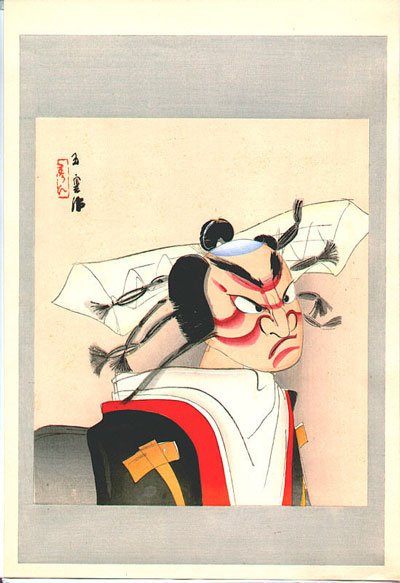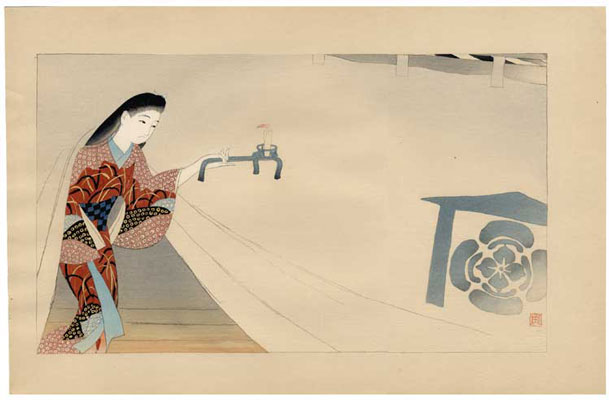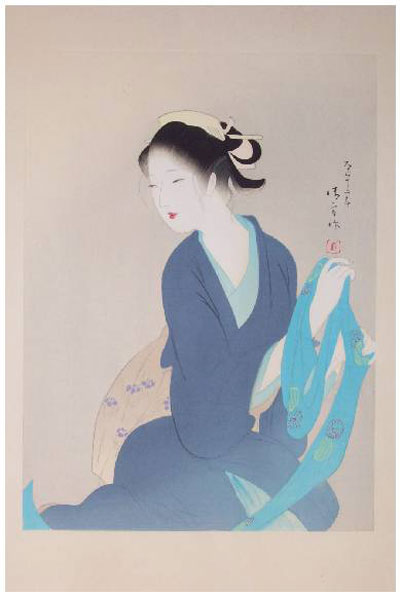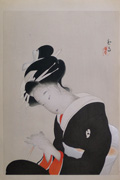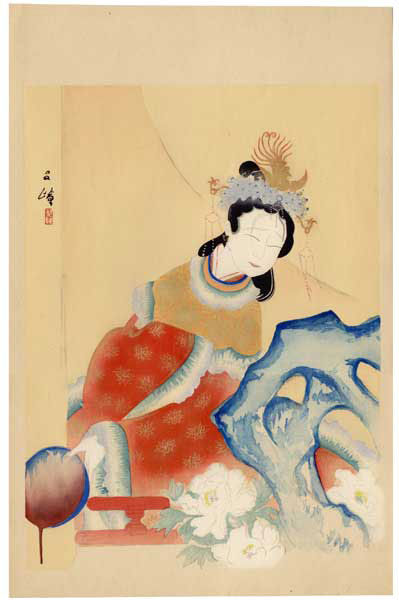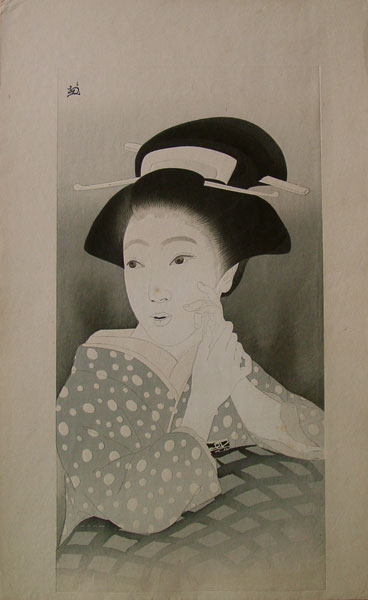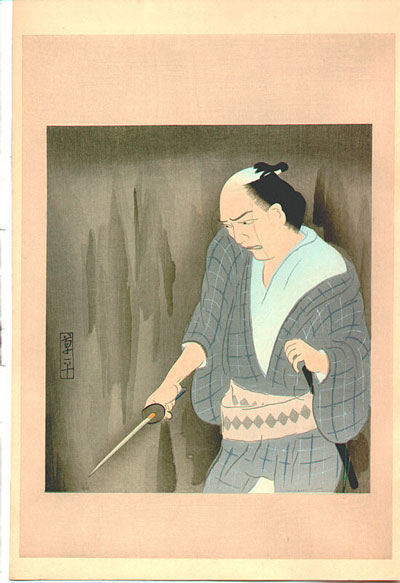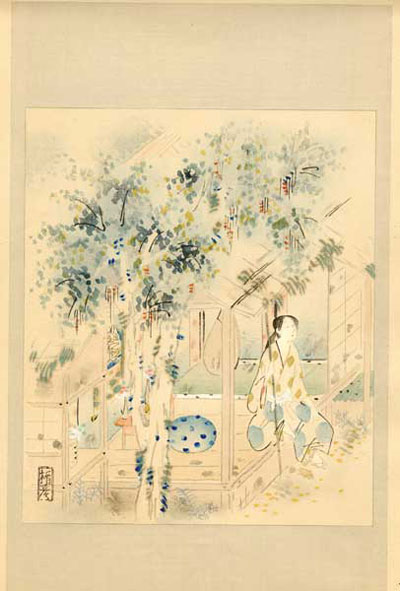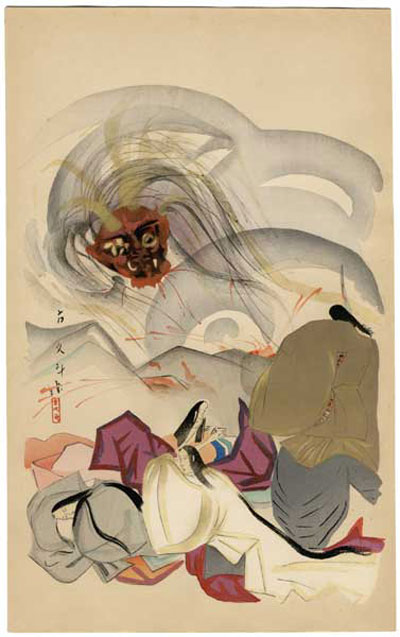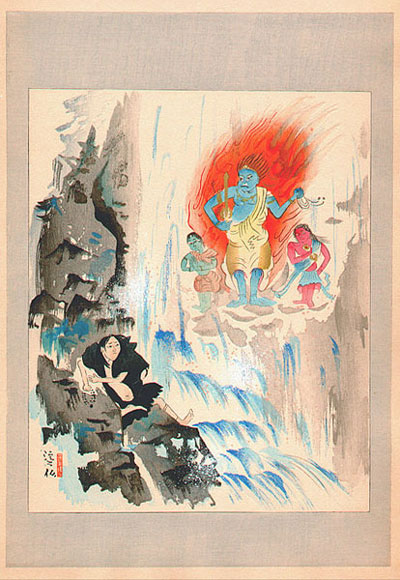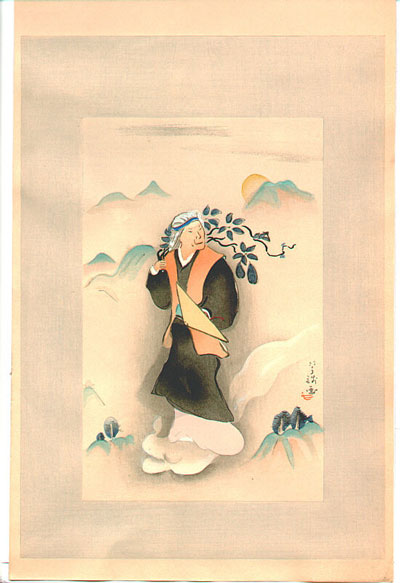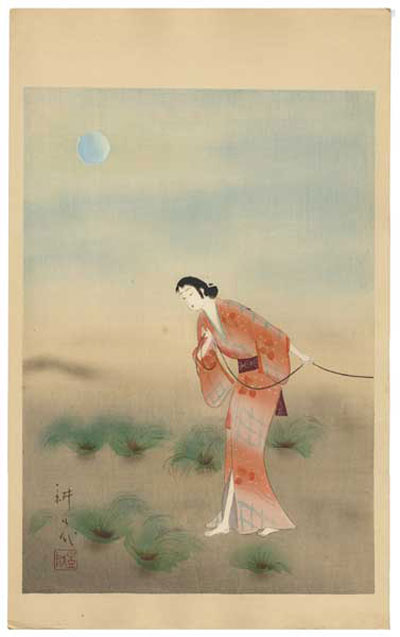Woodblock Print Supplements to
The Complete Works of Chikamatsu
Dai Chikamatsu zenshu furoku mokuhan
大近松全集 付録木版
The print series commonly referred to as Supplements of the Complete Works of Chikamatsu (Dai Chikamatsu Zenshū furoku) was published between 1922 and 1923 as part of the celebration of the two-hundredth anniversary of the death of Chikamatsu Manzaemon (1623-1724), perhaps the greatest dramatist in the history of the Japanese theater. Each design illustrates a scene or character from one of Chikamatsu’s famous works. The series consists of eighteen prints. Each print was designed by a different and well-established nihonga artist including Kitano Tsunetomi (1880-1947), Ishikawa Toraji (1875-1964), Yamamura Toyonari (1885-1942), Kaburagi Kiyokata (1878-1972) and two important female painters of the period, Shima Seien (1892-1970) and Uemura Shoen (1875-1949). Chikamatsu wrote over one hundred plays, most of which were written for the bunraku or puppet theater.
The blocks for the prints from this set were carved by Yamagishi Kazue 山岸主計 and printed by Nishimura Kumakichi 西村熊吉. Designs from the set are illustrated both in The New Wave: Twentieth-century Japanese prints fromthe Robert O. Muller Collection, Amy Reigle Stephens, BambooPublishing Ltd, London & Hotei-Japanese Prints, Leiden, 1993 and The Female Image: 20th Century Prints of JapaneseBeauties, Amy Riegle Newland and Hamanaka Shinji, Abe Publishing Ltdand Hotei Publishing, 2000. Many of the designs in the set have a printed gray border, reminiscent of the brocade borders found on hanging scrolls. In addition, many of the designs have deluxe highlights, including embossing, gofun, mica, and metallics.
The prints were issued as a supplement to a set of sixteen volumes of his work titled Dai Chikamatsu Zenshū, published between 1922 and 1925 by Dai Chikamatsu zenshū kankōkai 大近松全集刊行会 (the Complete Work of Chikamatsu Publishing Association). Scholten Japanese Art on their website notes that the prints were issued on a monthly basis starting in April 1922. I have seen mentioned that they were sold by subscription, but cannot recall the source.
The number of times each print was produced and the number of prints in each production is unknown, but there appears to be at least two different printings for each print, one which has the names of the printer and carver in the bottom margin in kanji, the other without that notation. Variations in coloration also are known for some prints, again, indicating multiple printings.
The blocks for the prints from this set were carved by Yamagishi Kazue 山岸主計 and printed by Nishimura Kumakichi 西村熊吉. Designs from the set are illustrated both in The New Wave: Twentieth-century Japanese prints fromthe Robert O. Muller Collection, Amy Reigle Stephens, BambooPublishing Ltd, London & Hotei-Japanese Prints, Leiden, 1993 and The Female Image: 20th Century Prints of JapaneseBeauties, Amy Riegle Newland and Hamanaka Shinji, Abe Publishing Ltdand Hotei Publishing, 2000. Many of the designs in the set have a printed gray border, reminiscent of the brocade borders found on hanging scrolls. In addition, many of the designs have deluxe highlights, including embossing, gofun, mica, and metallics.
The prints were issued as a supplement to a set of sixteen volumes of his work titled Dai Chikamatsu Zenshū, published between 1922 and 1925 by Dai Chikamatsu zenshū kankōkai 大近松全集刊行会 (the Complete Work of Chikamatsu Publishing Association). Scholten Japanese Art on their website notes that the prints were issued on a monthly basis starting in April 1922. I have seen mentioned that they were sold by subscription, but cannot recall the source.
The number of times each print was produced and the number of prints in each production is unknown, but there appears to be at least two different printings for each print, one which has the names of the printer and carver in the bottom margin in kanji, the other without that notation. Variations in coloration also are known for some prints, again, indicating multiple printings.
The Eighteen Prints
| IHL Cat. #1730 |
| Kikuchi Keigetsu (1879-1955 ) The Heroine Koharu in The Love Suicides of Amijima IHL Cat. #47 and #1114 | --d83e8a9d3b1b733e.jpg) The Heroine Umekawa in Meido no Hikyaku | 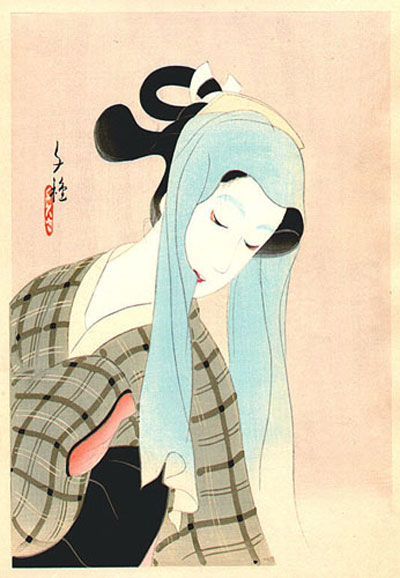 The Heroine Ochiyo in Sunju yoi koshin |
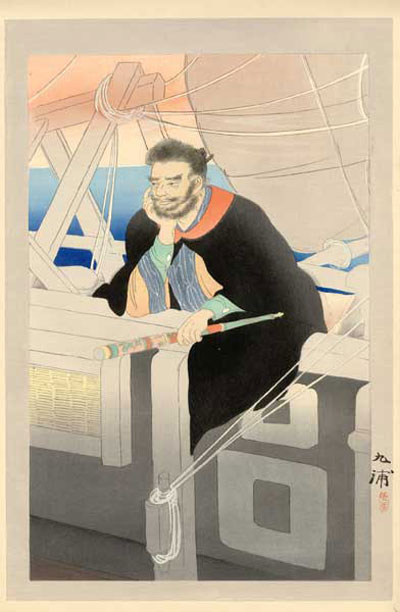 Noda Kyūho (1879-1971) The Sailor Kezori Kuemon in Hakata Kojoro Nami Makura IHL Cat. #136 | 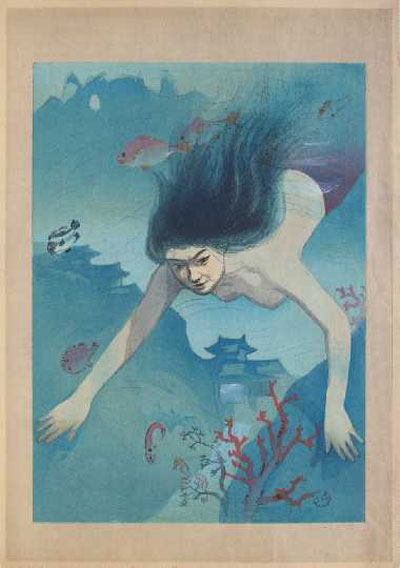 The Heroine Matsukaze in Matsukaze murasame sokutai kagami | Nishiyama Suishō (1879-1958) Princess Kinshōjo in Kokusenya Kassen IHL Cat. #147 |
| Okada Saburōsuke (1869-1939) The Heroine Osan in the play The Almanac-Maker's Tale IHL Cat. #203 | -The--82399fb654ae014e.jpg) The Heroine Yugiri in Yugiri Awa no Naruto | Yamaguchi Sōhei (1882-1961) Kabuki Actor with a Sword IHL Cat. #48 |
-Female-Ghost-web.jpg) Uemura Shoen (1875-1949) Female Ghost |
The Playwrite Chikamatsu Monzaemon
Source: Monlogue Archive website http://www.imagi-nation.com/moonstruck/clsc62.htmlBorn in Echizen, Japan in 1653 with the name of "Sugimore Nobumori", Chikamatsu Monzaemon was to become perhaps the greatest dramatist in the history of the Japanese theater. Born into a Samurai family, Chikamatsu's father went ronin, abandoning his feudal duties sometime between 1664 and 1670, and moving his family to Kyoto where they became attached to the local court aristocracy. This is most likely where Chikamatsu first became involved with the theater.
Chikamatsu is said to have written over one hundred plays, most of which were written for the bunraku (puppet) theater. His works combine comedy and tragedy, poetry and prose, and present scenes of combat, torture, and suicide on stage. Most of Chikamatsu's domestic tragedies are based an actual events. His Sonezaki shinju (The Love Suicides at Sonezaki), for example, was based on reports of an actual double suicide. In this play, an apprentice clerk and his lover, a prostitute in the pleasure quarters, finding no other way to be together, decide to commit a double suicide so that they can at least be united in death. Chikamatsu's most famous play, the Kikusenya Kassen or Battles of the Kikusenya, tells the story of a Tarter king's invasion of China after his demand for the Ming emperor's favorite concubine as the price of friendship is denied. A traitorous Chinese minister gives the signal for the invasion by stabbing out his own eye with a dagger, but a Chinese general, Go Sankei, miraculously defeats the huge Tarter army with a handful of soldiers. Unfortunately, the emperor's enemies have cut off his head during the battle and captured his concubine. Go Sankei rescues the concubine who is pregnant with the emperor's child, but when she is later hit by a bullet, he is forced to perform a Caesarean section in full view of the audience to save the imperial heir. He then sacrifices his own child in front of the Tarters in order to convince them that emperor's son is dead.
In 1705, Chikamatsu moved to Osaka where he became a writer for Takemoto Gidayu's puppet theater. He remained in Osaka until his death in 1725. Although he is generally considered the Shakespeare of Japanese theater, Chikamatsu's work is rarely performed, mainly because of the declining popularity of bunraku. Fortunately, several of his plays have been adapted for use in Kabuki theater and on film.
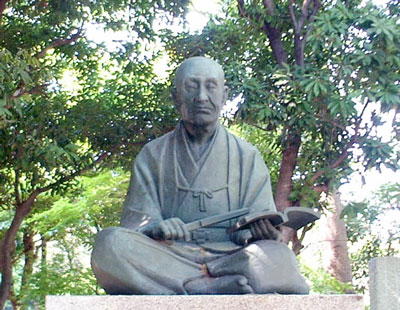
Chikamatsu is said to have written over one hundred plays, most of which were written for the bunraku (puppet) theater. His works combine comedy and tragedy, poetry and prose, and present scenes of combat, torture, and suicide on stage. Most of Chikamatsu's domestic tragedies are based an actual events. His Sonezaki shinju (The Love Suicides at Sonezaki), for example, was based on reports of an actual double suicide. In this play, an apprentice clerk and his lover, a prostitute in the pleasure quarters, finding no other way to be together, decide to commit a double suicide so that they can at least be united in death. Chikamatsu's most famous play, the Kikusenya Kassen or Battles of the Kikusenya, tells the story of a Tarter king's invasion of China after his demand for the Ming emperor's favorite concubine as the price of friendship is denied. A traitorous Chinese minister gives the signal for the invasion by stabbing out his own eye with a dagger, but a Chinese general, Go Sankei, miraculously defeats the huge Tarter army with a handful of soldiers. Unfortunately, the emperor's enemies have cut off his head during the battle and captured his concubine. Go Sankei rescues the concubine who is pregnant with the emperor's child, but when she is later hit by a bullet, he is forced to perform a Caesarean section in full view of the audience to save the imperial heir. He then sacrifices his own child in front of the Tarters in order to convince them that emperor's son is dead.
In 1705, Chikamatsu moved to Osaka where he became a writer for Takemoto Gidayu's puppet theater. He remained in Osaka until his death in 1725. Although he is generally considered the Shakespeare of Japanese theater, Chikamatsu's work is rarely performed, mainly because of the declining popularity of bunraku. Fortunately, several of his plays have been adapted for use in Kabuki theater and on film.

Statue of Chikamatsu Monzaemon at Amagasaki, Hyogo
